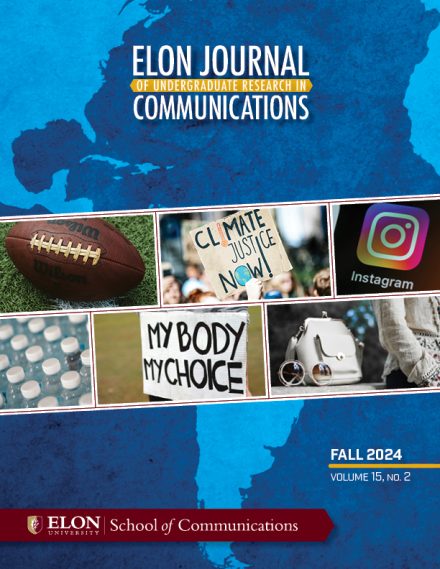The Elon Journal celebrates its 30th publication, highlighting nine student researchers exploring technology, identity and communication across digital and social landscapes.
The School of Communications has published the fall 2024 issue of the Elon Journal of Undergraduate Research in Communications, showcasing student research ranging from the influence of deepfake technology in politics to the portrayal of Corporate Social Responsibility in Super Bowl advertisements.

“The potential perils of new technologies and the manner in which they may shape our identities is a prominent theme,” said Professor Harlen Makemson, who serves as the journal’s editor.
The issue features nine research papers authored by students in the School of Communications. The edition opens with Jessie Cordwell’s examination of how social media users construct identities online and how self-presentation varies across platforms like Instagram, LinkedIn and various dating apps. Through a dual-method approach involving an anonymous survey and optional short-form individual interviews, the strategic communications major discovered that most respondents had, in some way, altered their online identities.
Gianna Smurro investigated how political bias influences people’s judgment of online content authenticity, emphasizing the risks posed by deepfake technology in exploiting such biases. Based on her findings, the journalism and cinema and television arts double major urged social media platforms and media consumers to actively evaluate deceptive content to uphold democratic integrity.
Journalism major Naomi Washington examined Black college-age women’s perceptions of health data security in the context of using menstrual cycle tracking applications after the overturn of Roe v. Wade. Through eight semi-structured interviews, she founded that nearly all participants had changed how they used these applications, citing concerns about potential misuse of their personal data.
Two student researchers – both strategic communications majors – focused on environmental communication, with Katelyn Litvan taking an experimental approach to examine perceptions of environmental advocates on Instagram. Her findings indicated that the “intellectual advocate” is perceived more authentic and more credible than both the “celebrity advocate” and the “ordinary person advocate.” Claire Kenealy used focus groups to explore how environmental organizations can use social media to engage young audiences, differentiating between optimistic and pessimistic messaging. Interestingly, this study indicated that pessimistic content regarding climate change cannot be abandoned but must be strategically utilized.
Three student scholars examined communication in marketing and commercial contexts. Strategic communications major Maeve Galway used a historical lens to analyze a strategic shift in Super Bowl television advertising, where brands increasingly employ Corporate Social Responsibility to improve their public image and meet consumer expectations. In the realm of fashion communication, journalism major Madi Keller found that traditional journalists prioritize authority and credibility, while social media influencers focus on personal narratives and interactive engagement. Additionally, communication design major Ryan Margaret Lee analyzed how digital marketing strategies shape consumer identities in the competitive water bottle market, focusing on three visual brands: Stanley, Owala and Hydro Flask.
Lastly, communication design major Matt Newberry addressed the educational potential of board games in linguistic competency. His research detailed the process of developing and designing an innovative, dual-language, multigenerational board game.
For the fall 2024 issue, Makemson assembled an editorial board of 27 communications faculty members who participated in the multiple blind-review process to select the best student work.
The Elon Journal began in spring 2010, with spring and fall editions each year. The fall 2024 journal marks its 30th edition. In recent years, the journal transitioned to become fully online, with each individual research paper available on its own respective webpage – increasing the content’s accessibility.
The Council on Undergraduate Research catalogs more than 200 student research journals in the nation, and the Elon Journal is one of the few that focuses on undergraduate student research in journalism, media and communications.


